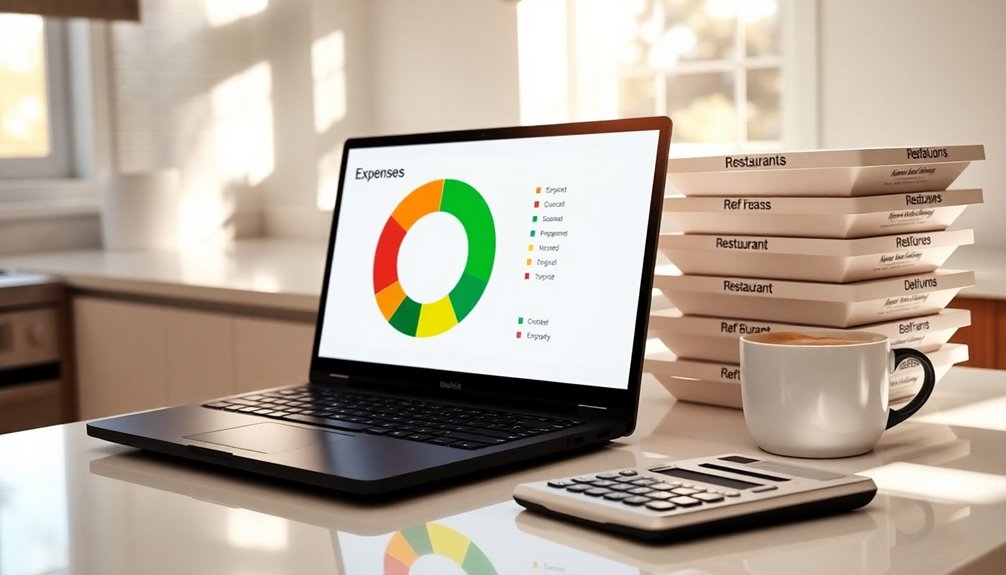To set aside taxes using separate bank accounts, open a dedicated account just for your tax savings. Regularly transfer a calculated percentage of your income into this account—consider automating the deposits to stay consistent. Keep track of your contributions and stay aware of tax deadlines to guarantee you have enough funds when payments are due. Continuing with these steps helps you stay organized and stress-free come tax time; discover how to make this process even easier.
Key Takeaways
- Open a dedicated savings account exclusively for tax funds to keep them separate from daily expenses.
- Regularly transfer a percentage of your income into the tax savings account based on your estimated tax liability.
- Automate deposits to ensure consistent contributions and reduce the risk of forgetting deadlines.
- Mark important tax deadline dates on your calendar and set reminders for timely payments.
- Review and adjust your transfers periodically to match changes in income or tax obligations.

Managing your taxes can feel overwhelming, but setting aside money regularly makes it much easier. One effective way to do this is by using a separate bank account dedicated solely to your tax savings. This approach helps you stay organized and guarantees you’re not tempted to spend the money you’ve earmarked for taxes. By consistently contributing to this account, you reduce the stress when tax deadlines approach and avoid scrambling for funds at the last minute. It’s a simple yet powerful method to maintain control over your finances.
Set aside money regularly in a separate account to stay organized and stress-free at tax time.
To make this system work smoothly, you should familiarize yourself with your tax calendar. The tax calendar outlines key deadlines for filing returns and making payments, including estimated payments for those who are self-employed or have income not subject to withholding. Estimated payments are essential because they help you spread out your tax liability throughout the year, preventing a large, unexpected bill at tax time. Mark these dates clearly on your calendar and set reminders to make timely deposits into your dedicated tax account. This proactive step guarantees you stay compliant and reduces penalties or interest charges.
When you receive income—whether from freelance work, investments, or business sales—calculate the approximate amount you’ll owe in taxes. Based on this estimate, decide how much to transfer into your separate account each month or quarter. Regular contributions aligned with your estimated payments create a steady habit that prevents last-minute scrambles. Many people find it helpful to set up automatic transfers on the same schedule as their estimated payments. Doing so minimizes the chance of forgetting or delaying, keeping your tax savings on track.
The key to success is consistency. Treat your tax savings account like a non-negotiable bill—just like rent or utilities. By doing so, you develop a disciplined habit that guarantees funds are available when it’s time to pay your taxes. Also, regularly review your income and expenses to adjust how much you save, especially if your income fluctuates. Staying on top of your financial situation allows you to make accurate estimated payments, avoiding underpayment penalties.
Frequently Asked Questions
How Much Should I Allocate for Taxes Each Month?
You should allocate about 25-30% of your income for taxes each month, depending on your tax deduction and expense categorization. Review your previous year’s tax bill to determine a more accurate amount. Setting aside this portion helps you avoid surprises come tax time. Use your separate bank account to easily track and manage these funds, ensuring you’re consistently prepared and can easily cover your tax obligations without stress.
Can I Use a Joint Account for Tax Savings?
Did you know nearly 60% of couples combine accounts for convenience? You can use a joint account for tax savings, but consider the risks. Merging accounts simplifies tracking income and expenses, yet it may complicate separating personal and business funds later. Be clear about account purposes and make sure both parties agree. A dedicated joint account can work if you manage it carefully with transparent account merging strategies.
What if I Forget to Transfer Funds Regularly?
If you forget to transfer funds regularly, you risk missing tax payments and facing penalties. To prevent this, set up a tax calendar with clear deadlines and use payment reminders on your phone or email. Automate transfers if possible, so funds move into your tax account consistently. Staying organized and proactive guarantees you meet deadlines and avoid costly penalties, keeping your finances on track.
Are There Specific Bank Accounts Ideal for Tax Purposes?
Imagine a dedicated vault where your tax deposit stays safe—specific bank accounts for tax purposes work just like that. Look for accounts with bank segregation, designed to keep your tax funds separate from everyday expenses. These accounts often offer better tracking and protection, making it easier to manage your tax obligations smoothly. Choosing the right account helps you stay organized, ensuring your tax money is always ready when deadlines arrive.
How Do I Track Tax Savings Over Time?
To track your tax savings over time, you should regularly perform investment tracking and account reconciliation. Keep detailed records of your deposits into your tax-specific account and compare them against your income and expenses. Use spreadsheets or financial software to monitor your progress, ensuring your savings grow as planned. Regularly reconciling your accounts helps you spot discrepancies early, so you stay on top of your tax-saving goals effortlessly.
Conclusion
By setting aside your taxes in a separate account, you’re not just managing your money—you’re taming the financial beast before it roars. Think of it as planting a seed today that will grow into a safety net tomorrow. With discipline and a dedicated account, you’ll turn tax season from a dreaded surprise into a predictable win. So, take control now—your future self will thank you for the peace of mind you’re building.








